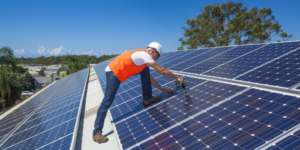
2020 was a turbulent year for many industries — and despite seeing a large amount of growth, the solar industry is still finding its footing.
In spring 2020, any fears that solar panel installation would plummet in the face of a pandemic-induced economic downturn quickly dissipated. As more employees moved to full-time remote work — and used more energy at home during the day — homeowners looked to solar panels to reduce electric bills and power outages, according to a report in the Chicago Tribune.
However, solar companies still face financial hurdles. On January 20, 2021, solar panel manufacturer Sunergy California LLC filed for Chapter 11 bankruptcy protection.
“They are seeking to reorganize while continuing to operate,” Rosendo Gonzalez, counsel for Sunergy California with the Los Angeles firm Gonzalez & Gonzalez Law, told the Sacramento Business Journal.
According to the Business Journal, one of Sunergy California’s largest debts is to Depcom Power Inc., an Arizona-based industrial-scale solar developer. According to Sunergy’s filing, they face a court judgment of $3.7 million from Depcom, which is still disputed and on appeal.
Sunergy currently has more than $10 million in assets and $17.2 million in liabilities, and experienced a loss of $1.6 million in gross revenue in 2019, according to their bankruptcy petition.
2020 produces upturn in solar panel installation
Many solar companies have flourished despite the negative economic effects of the coronavirus pandemic, as solar panel installation experienced unprecedented growth.
Manufacturers installed a record 137 gigawatts of new solar in 2020. Active Solar, Pascal Rochat’s solar panel firm, gained a 183 percent return in the same year. Two of the country’s largest residential home solar manufacturers, Sunnova and Sunrun, saw their stock jump by more than 300% and 400% respectively.
W. John Berger, chief executive of Sunnova, told the Chicago Tribune: “We’re having discussions as a management team about how much growth we can handle. I’ll take that problem any day of the week because I’ve had the other problem, as well.”
Industry experts don’t expect the growth to stop. Remote work has become a more permanent situation for much of the American workforce, and many people making home improvements or shopping for a new home see solar panels as a long-term savings strategy.
In North Carolina alone, around 5,500 Duke Energy customers installed private solar panels at their businesses and residences. Research and consulting firm Wood Mackenzie and the Solar Energy Industries Association told the Chicago Tribune that they predict new home solar installations will grow seven percent in 2021, with strong growth to continue over the next five years.
Duke Energy, which serves 7.4 million customers around the US, has been expanding its own solar efforts on a large scale. The company recently completed the 700,000+ panel Rambler Solar Project in San Angelo, Texas, and has already begun construction on the similarly sized Texan Holstein Solar Project.
“We’re pleased to continue our expansion of solar energy resources in Texas, which is experiencing an increasing demand for power,” said Chris Fallon, president of Duke Energy Renewables, in an interview with Solar Industry.
Solar industry faces profit struggles despite growth
Major solar expansions have not come without hurdles — in January 2021, Duke’s aforementioned Rambler Solar Project faced an active unpaid construction work claim — also known as a mechanics lien — worth over $4 million, according to the Tom Green County clerk’s office.
And, despite the surging market, the solar industry has struggled to become profitable. In January 2020 — even before any large business impacts from the coronavirus pandemic — SunPower announced that it was cutting up to 160 jobs. In June of the same year, California roofer and solar installer PetersonDean filed for Chapter 11 bankruptcy protection.
Both PetersonDean and Sunergy had been hoping to have a home-state advantage in California, where building codes enacted in 2020 required new homes to include solar panels, according to Green Tech Media, but that boost was not enough to prevent bankruptcy. Even Sunrun and Sunnova lost a combined $500 million despite their dramatic stock increases, according to the Chicago Tribune report.
Solar insiders told the Chicago Tribune that the industry’s rapid growth and the large upfront costs that installations demand are to blame for some of these losses. The collective cost of operations and purchases of solar systems of Sunnova and Sunrun cost $1.3 billion in cash last year.
New presidential administration brings hope of stabilization to solar industry
Tax incentives and new government policies may help stabilize the solar industry. During his campaign, President Biden debuted a national plan to reach 100 percent clean electricity by 2035, according to the Green Tech Media report. As president, Biden announced a $2 trillion plan on clean energy.
These government investments could offset the upfront costs solar companies face and position them for long-term stability and profit. Green Tech Media reported that one version of this investment, the Investment Tax Credit, is already in place for 26 percent through 2022 and 22 percent until the end of 2023.
The clean energy industries are one of the largest points of focus of President Biden’s construction-related plans. The incoming administration has many initiatives planned that will directly impact the construction industry — read more about what they are and stay informed with 11 Ways President Biden Plans To Impact Construction.